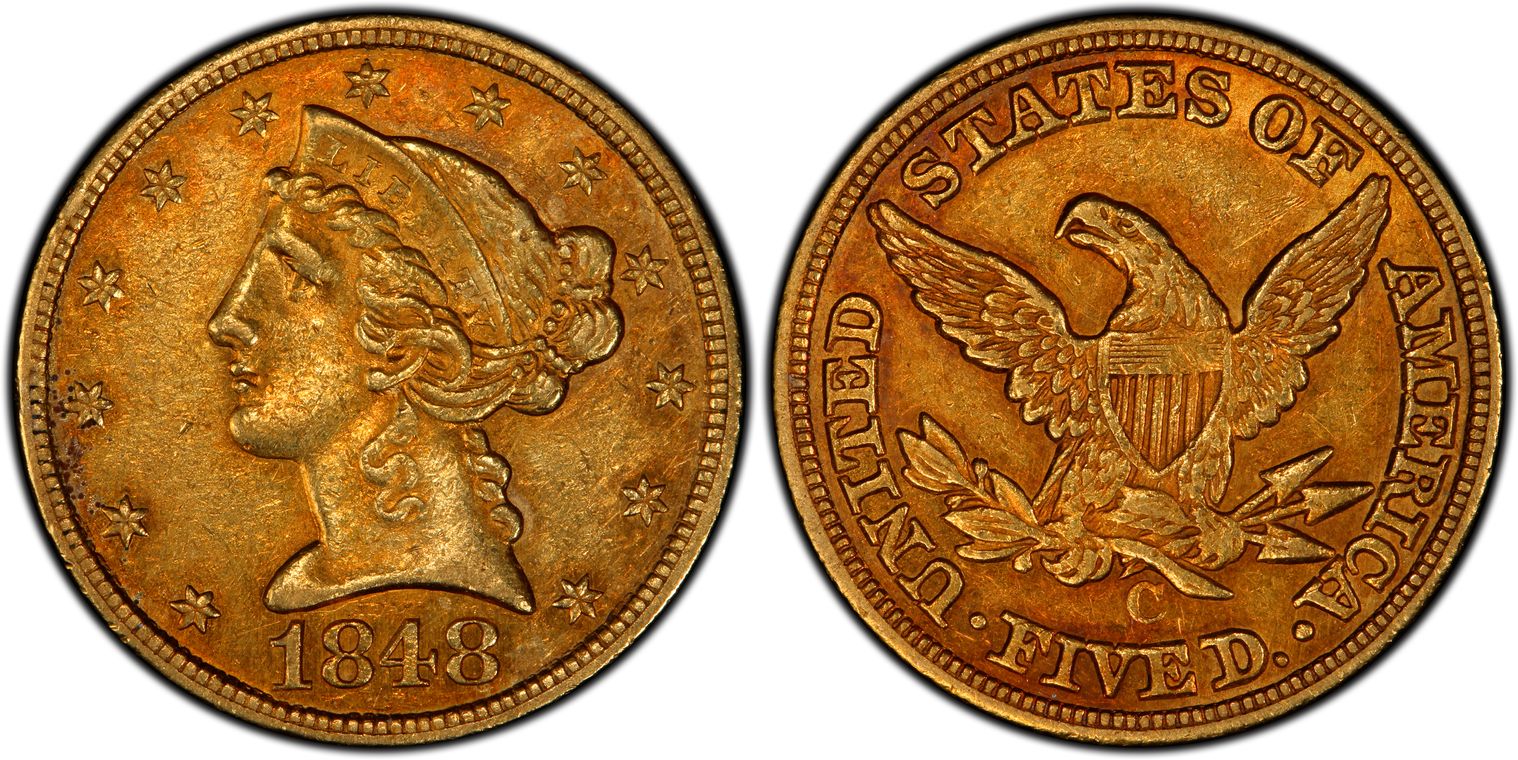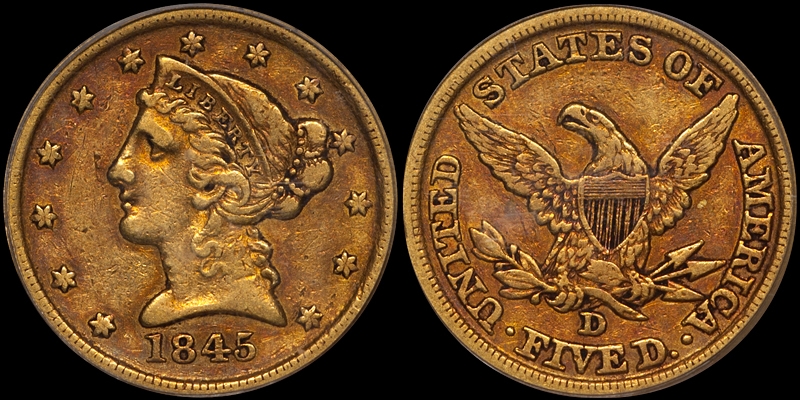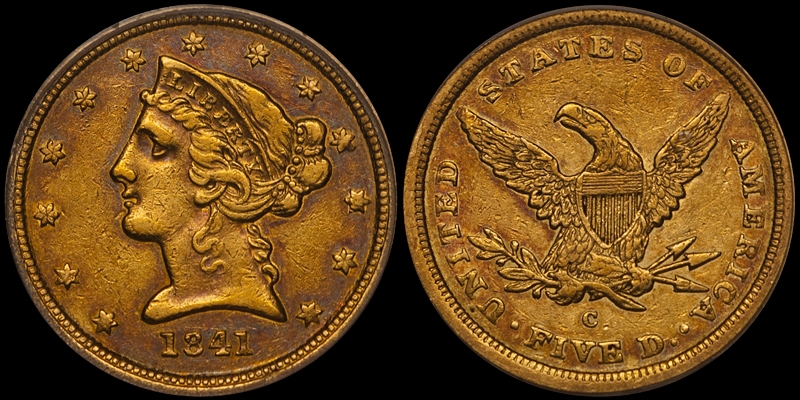Unusual, CAC-approved toning on gold
 ranshdow
Posts: 1,445 ✭✭✭✭
ranshdow
Posts: 1,445 ✭✭✭✭
Apropos of a BST thread about an old commemorative coin up for auction. Here are a couple examples of toning on gold coins that has been CAC approved.


Feel free to share other examples.
14
Comments
I may not know what I’m talking about, but the California 1850 coin looks beautiful to me!
Collector of randomness. Photographer at PCGS. Lover of Harry Potter.
I have never seen that dark of toning on gold before but, I am relatively new to the hobby. That California eagle looks so odd I can't describe it but it is really funny to me.
A government accident left me a former man, a potato. That photo on my profile is a low resolution selfie. I like coins.
I love old gold with that look. Great coins especially the California piece.
Stick around, you will. At least one member here collects them and posts his new purchases.
Latin American Collection
From my experience smaller sized US gold typically tones in the fields with lighter areas around the devices (like the 1846 $5). On a few coins, like the territorial, the toning is inverse and surrounds the devices but not the fields. In discussing this with Doug Winter he called it "leather pouch" toning where the tannins in the pouch (or wood box, etc) is imparted to the surfaces of the coin in that pattern.
Latin American Collection
This 1848-C $5 ex. Littlejohn has similar toning around the devices

Latin American Collection
and another which RYK and I have traded back and forth...

and this one which I sold a long time ago

Latin American Collection
That coin is a example of a pioneer/territorial gold piece (note MOFFAT&Co instead of LIBERTY). The design details and execution of these, in general, tend to be cruder than contemporary U. S. Mint products. And that is part of their charm.
RMR: 'Wer, wenn ich schriee, hörte mich denn aus der Engel Ordnungen?'
CJ: 'No one!' [Ain't no angels in the coin biz]
Paging @jwitten ...
BTW, I had this one that I was concerned about the toning on go gold cac:
The 1867 below shows some of the 'inverse toning' boosibri describes. The 1869 has some areas around the devices that are lighter and darker than the adjacent fields, particularly on the reverse. Both coins are CAC.


I am in a location with very spotty internet for the next few days, so this was my first chance to check in. Ooohhh boy, gold toning is my thing. I have a ton of them. I just recently was accepted to CAC, and have not sent any of my toners in myself, but I know of two that are CACed. One I still have (the $2 1/2), one I sold fairly recently (the $10, and the new owner CACed it). Here they are:








Oh, and for what it's worth, I had a foreign that is WINGed. I think it is the foreign equivalent of cac. Here it is:
I like that rustic look, thanks for sharing !!!
Here's an interesting pair of well-worn $10's with residual toning around the devices. Clearly these have been cleaned, but not harshly. There is a touch of irridescence in the color of these coins that shows up in hand.


I'm thinking about sending my cac 1908 $2 1/2 to pcgs. I hate losing the CAC, but I would rather have trueviews of it.
Don’t like a lot of them, not a buyer sticker or not.
Pioneer Gold like that often has a lot of silver in it, which will tone when exposed to the elements (or the inside of a leather pouch) - most advanced collectors of the series prefer the deeply toned, crusty look.
I was the guy who got that coin graded, if I'm not mistaken.
What is now proved was once only imagined. - William Blake
David doesn't gold mined in California have the tendency to tone a little on the red side on occasion?
mark
Fellas, leave the tight pants to the ladies. If I can count the coins in your pockets you better use them to call a tailor. Stay thirsty my friends......
I've seen a lot of coppery red and magenta, although blue, brown, and green can show up too. When it gets circulated, it tends to darken (especially with a nice coating of natural muck).
What is now proved was once only imagined. - William Blake
I was having this very conversation with JD and Shamhart in Vegas last week. I couldn't take notes fast enough.
mark
Fellas, leave the tight pants to the ladies. If I can count the coins in your pockets you better use them to call a tailor. Stay thirsty my friends......
I've been having a lot of conversations like this with JD lately. It's always a pleasure. I'm happy he's on the West Coast now.
What is now proved was once only imagined. - William Blake
Gold from California sometimes has green tones due to the iridium, which was nearly impossible to remove at the time and in later years very cost prohibitive.
I'd love to know about reds.
Here you guys go!
www.paradimecoins.com - Specializing in Top Pop Type PCGS CAC coins. Subscribe To Our NEWPs Mailing List
It was originally graded NGC AU58 and sold by AU Capital Management to SteveBen....SteveBen crossed it to PCGS at AU55 and sold it to me by way of DWN...
It's funny the circular path that these coins take...I sold the 1850 Moffat in the original post (ex-RYK) to free up funds to purchase the Clark Gruber!!!
I would like to see RYK return to the Forum. A few others too.
RMR: 'Wer, wenn ich schriee, hörte mich denn aus der Engel Ordnungen?'
CJ: 'No one!' [Ain't no angels in the coin biz]
I find the comments on trace minerals (iridium, silver etc.) in the old California gold to be quite interesting...Although unlikely to happen, it would be great to see an XRF analysis of the metals in these coins... Cheers, RickO
California gold had a higher concentration of copper vs the southern branch mints which contained higher silver which is what creates the greenish gold common to the early southern mints which used local gold.
Iridium was found in Dahlonega gold in the late 40’s to 50’s (per a great article by forum member @GeorgeKellogg). I have never heard of iridium in California gold. Iridium often comes from meteorites IIRC, much less so than in the earths crust, so bluish gold is actually made from space elements.
Latin American Collection
I had one just like it in an NGC 58 holder the I crossed into a 30th anniversary slab when they were doing those...
What is now proved was once only imagined. - William Blake
Fred Holabird, the americana auctioneer and consulting mining geologist, told me that some California gold deposits do bear trace amounts of iridium and maybe other transition metals. If memory serves, it was in the gold found in some of the southern deposits. I have the notes from the conversation somewhere.
Hmm. Trace amounts of iridium, the bulk of which is associated with an ancient, mass extinction event on Earth. So, were dinosaurs trading gold just before kicking the bucket? Just trying to connect the dots.
RMR: 'Wer, wenn ich schriee, hörte mich denn aus der Engel Ordnungen?'
CJ: 'No one!' [Ain't no angels in the coin biz]
The article I referenced:
https://goldrushgallery.com/news/coloration.html
Latin American Collection
You can see dinosaurs trading gold at just about any coin show
LOVE the color on that one!
My YouTube Channel
Now that's funny. I don't care who you are!
My most colorful gold toner:
While not as stunning as some of the coins here, these two have a certain degree of patina:
I think you meant to say that S-mint gold coins have a higher concentration of copper vs. southern branch mint gold coins, which contain a higher silver content.
California mined gold, generally, was not as pure as southern gold. It had a higher silver content beyond alloy limits, which required the silver to be parted from the gold. Southern gold was very pure, which enabled the mints to bypass the parting of silver from gold, but resulted in gold coins that had as much as 5% silver content (1830's-1850's). This was quite fortuitous, as the branch mints were not adept at parting gold during the early years due to several production issues. I have done some recent archival research that supports the fact that in the early years at the branch mints southern gold was not parted of silver.
In the 1830's the Philadelphia mint had a policy of using an alloy of 2/3 copper to/1/3 silver. Later, after receipt of gold coin and bullion from the French Indemnity payments which influenced gold coin production in the U.S., and the passage of the Coinage Act of 1837, the mix changed to 70% copper and 30% silver. At the same time, the southern branch mints were manufacturing coins with about 5% silver. Fast forward into the 1850's and I believe that the alloy changed yet again to the favor of copper. I don't know the policy and procedure for S-mint gold alloy starting in the 50's, but my guess is that it was lock step with Philadelphia.
Well done! Looks like I became the straight man for a real comedian. :'(

RMR: 'Wer, wenn ich schriee, hörte mich denn aus der Engel Ordnungen?'
CJ: 'No one!' [Ain't no angels in the coin biz]
Au50 CAC
Two questions, what grade is that and do you know what makes that metallic silver color? I've seen it before on some coins.
My YouTube Channel
The grade is MS64. I do not know what chemical causes that color. Others have mentioned iridium. This is the color in uncirculated condition. It darkens with wear.
One of my favorite toned gold dollars.
or maybe this one:
one last dollar.
Overland Trail Collection Showcase
Dahlonega Type Set-2008 PCGS Best Exhibited Set
Just love that Indian princess! Similar kady on some civil war tokens I have. Great array. Peace Roy
BST: endeavor1967, synchr, kliao, Outhaul, Donttellthewife, U1Chicago, ajaan, mCarney1173, SurfinHi, MWallace, Sandman70gt, mustanggt, Pittstate03, Lazybones, Walkerguy21D, coinandcurrency242 , thebigeng, Collectorcoins, JimTyler, USMarine6, Elkevvo, Coll3ctor, Yorkshireman, CUKevin, ranshdow, CoinHunter4, bennybravo, Centsearcher, braddick, Windycity, ZoidMeister, mirabela, JJM, RichURich, Bullsitter, jmski52, LukeMarshall, coinsarefun, MichaelDixon, NickPatton, ProfLiz, Twobitcollector,Jesbroken oih82w8, DCW
Those are sweet!!!
My YouTube Channel
Was always curious about this one if anyone has any comments. ANACS called it a VF35 thoughts on what on earth is going on here?
I have had a few 1903 McKinley commemoratives with this silvery toning around the edge and the devices.
I've seen that silver toning, I think it's cool looking!
My YouTube Channel
Good thread. Enjoy the pics.